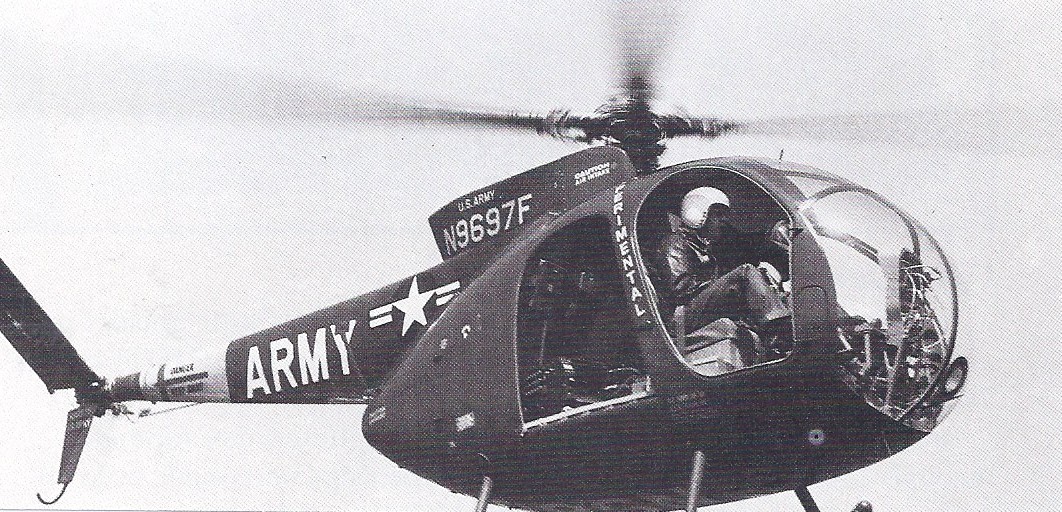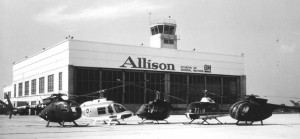

First Flight of Hughes 369 (OH-6) by Jack Schweibold –
A late entry in the Army’s Light Observation Helicopter (LOH) program, the OH-6’s first flight was over fifty years ago on February 27th, 1963 when it slipped into the competition … seemingly under the cloak of a Howard Hughes movie plot. As Allison Engine’s test pilot I was commissioned by the Army to be the first to evaluate the three competitors: Hiller, Bell and Hughes …
I wouldn’t meet Howard until a later trip, but it was still inspiring to walk into Hughes Aircraft Company (HAC). HAC was Howard’s private aircraft “skunk works” facility at Culver City, California. HAC was fairly close to MGM’s studios. This was his airport as he owned all the surrounding ground which was sold for a small fortune upon his death. It ran from the Pacific ocean beach to the expressway and also appeared to be Howard’s own private movie set.
My first memory of the place was seeing a giant, long-bladed heavy lift helicopter with a high pogo stick gear – it must have been his effort for the flying crane market won by Sikorsky. There were a number of similar abandoned aircraft projects that came off Hughes’s personal drawing board which never made it to prodcution. It was easy to picture his Spruce Goose parked nearby in an air-conditioned preservation hangar, a plywood Goliath that he piloted to an altitude of ten feet over the bay . . . against the military’s wishes. While glancing around these wonderous project aircraft we were startled by a loud “BARROOMM!!!” We were hearing the regular, explosive firing of Hughes’s new version of the Gatling gun the gensis of which is still used today. This was one of the production pieces scheduled soon to mow down the Vietnamese jungles. The OH-6A would be one of Howard’s last projects of personal involvement.
Stepping into the Flight Test Section, a small WWII type shack, I met my old acquaintance, Bob Ferry, Hughes Chief Test Pilot. Bob had observed my inverted flight maneuver in the Sikorsky H-19 at Oxnard five years earlier – but that’s another story to be told later. After several hours of pre-briefing and with Hughes unique design where you had to be a proctologist to examine the engine located in its lower rear-end, we took to the air in “The Egg”. Ferry reassured me as we walked to the ship, “An egg is aerodynamically perfect and effectively crush-resistant”. Nevertheless, we proceeded to the helicopter in crash helmets and Nomax flight suits. Ferry continued to expound on the design philosophy, “An exceptional light weight concept maximizing speed, high payload and agility . . . that’s how we made the competition. Bell and Hiller are old heavyweights. We’re the new kids on the block”. I wasn’t at all convinced that this egg was crush-proof!
The ship looked like micro-thin tinfoil wrap with toothpick structural members. The main rotor had four mini-blades, a light-inertia concept that left a lot to the imagination and raw skill when making power off autorotation touchdowns. Similar lightweight rotor designs, which previously equated with hard landings and broken backs, were never popular with instructor pilots. Once we were in the air, it was shake, rattle, and roll. My job was to evaluate engine response, same as my evaluations of the Hiller and Bell competitors, the result was the engines were slow. My departing critique held no punches on the heavy vibratory flight loads. I figured since they asked me, I’d tell the truth. They confessed their findings were parallel and tried to assure me they were “working on it.” A phrase I would soon hear often and would occasionally use myself. I couldn’t say yet that we were “working on” our engine’s slow acceleration but I did assure them I would report it as an unacceptable problem. This is the unenviable postion of being a test pilot: your job is to report anomolies and problems but the engineers who concieved this baby typically do not appreciate hearing their child has issues. Each of the systems designers – engine, avionics, airframe tend to protect their children and point fingers back the other way. After many internal battles, Allison’s engineers realized that to make their baby work in all three helicopters the engine’s acceleration would need to be improved.
Yes, Allison cut seconds out of acceleration times, Hughes smoothed out the rotors and the Army received ships at Fort Rucker from the three entrants for test to determine the winner. At Allison, we eventually received one each of the competitor’s helicopters for further development.
(Excert from Chapter 13, “In The Safety Of His Wings” by Jack Schweibold, copyright 2005/2012) http://www.amazon.com/The-Safety-His-Wings-Adventures/dp/0976918617/ref=sr_1_3?ie=UTF8&qid=1338476894&sr=8-3

